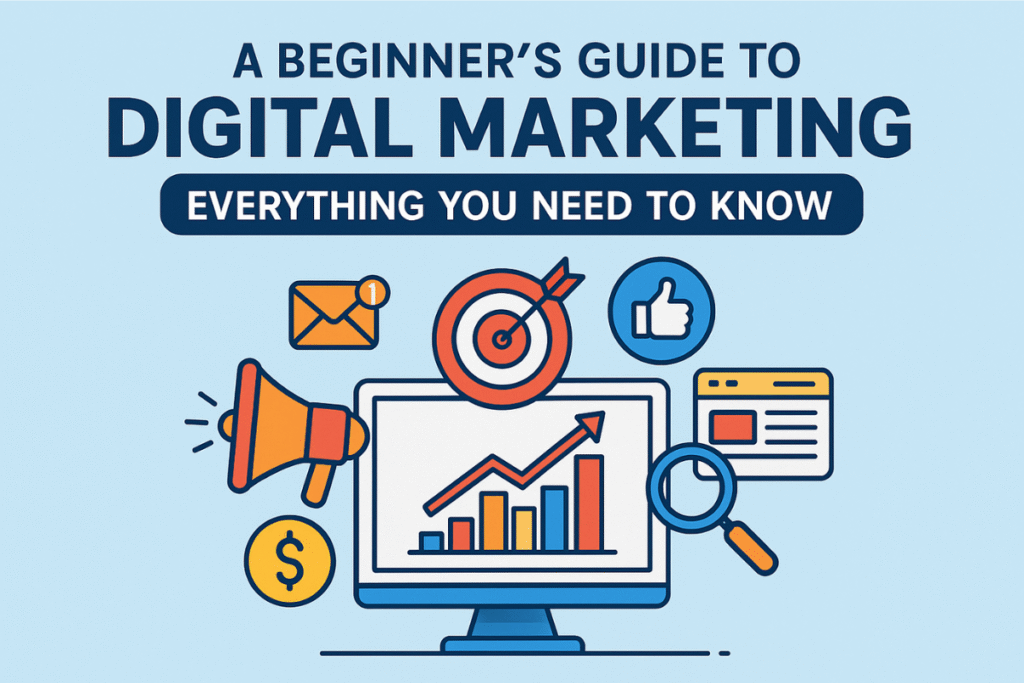Digital marketing is an essential part of any modern business. Whether you’re a small business owner, a marketer, or just curious about how digital marketing works, this beginner’s guide is perfect for you. In this guide, we’ll cover everything from the basics of digital marketing to the latest trends and best practices. By the end of this guide, you’ll have a solid understanding of digital marketing and be ready to start using it to grow your business.
What is Digital Marketing?
Digital marketing is the practice of promoting products or services using digital technologies, such as the internet, mobile devices, social media, search engines, and other online channels. Unlike traditional marketing methods, which rely on print ads, billboards, or television, digital marketing leverages technology to connect directly with customers where they spend most of their time—online.
It involves creating and distributing content, running paid campaigns, optimizing websites for search engines, and building strong relationships with customers through various digital touchpoints.
In short, digital marketing allows businesses to:
-
Reach a global audience
-
Target specific customer groups
-
Track and measure performance
-
Engage with customers in real time
Why is Digital Marketing Important?
In today’s fast-paced world, consumers are spending more time online than ever before. Whether it’s browsing social media, shopping online, or searching for information, your customers are already online.
Here are a few reasons why digital marketing is critical for businesses:
-
Wider Reach – Businesses can connect with audiences across the globe, breaking geographical limitations.
-
Cost-Effective – Digital campaigns are often more affordable than traditional advertising.
-
Targeted Marketing – You can focus your efforts on specific demographics, interests, or behaviors.
-
Measurable Results – Tools like Google Analytics help track performance in real time.
-
Better Engagement – Social media and email marketing foster direct communication with customers.
Without a digital presence, businesses risk losing relevance and visibility.
Types of Digital Marketing
There are several forms of digital marketing, each with unique strategies and benefits. Let’s explore the most common types:
1. Content Marketing
Content marketing is all about creating and sharing valuable, relevant, and consistent content to attract and engage your audience. Examples include blogs, videos, infographics, podcasts, and eBooks.
2. Search Engine Optimization (SEO)
SEO focuses on improving your website’s visibility in search engines like Google. This involves keyword research, on-page optimization, backlink building, and technical SEO. The goal is to rank higher and drive organic traffic.
3. Pay-Per-Click Advertising (PPC)
PPC is a paid advertising model where you pay each time someone clicks on your ad. Platforms like Google Ads and Bing Ads are popular for running PPC campaigns.
4. Social Media Marketing
Using platforms like Facebook, Instagram, LinkedIn, and Twitter, businesses can build awareness, engage audiences, and promote products.
5. Email Marketing
Email campaigns help businesses stay in touch with customers, deliver personalized offers, and build long-term relationships.
6. Affiliate Marketing
This involves partnering with individuals or companies who promote your products in exchange for a commission on sales.
7. Influencer Marketing
Brands collaborate with influencers to promote products to their loyal audiences.
8. Video Marketing
Videos on platforms like YouTube, TikTok, and Instagram Reels help brands connect with audiences in an engaging and visual way.
Creating a Digital Marketing Strategy
Having a well-structured digital marketing strategy ensures your efforts are targeted and effective. Here are the steps to build one:
-
Define Your Goals – Are you aiming for brand awareness, lead generation, or sales?
-
Know Your Audience – Create buyer personas to understand demographics, interests, and online behavior.
-
Select the Right Channels – Choose platforms that align with your target audience.
-
Create Valuable Content – Develop blogs, videos, or infographics that solve customer problems.
-
Set a Budget – Allocate resources wisely between paid and organic strategies.
-
Track Performance – Use analytics tools to measure results and refine strategies.
Content Marketing: Building Trust Through Value
Content marketing is one of the most powerful ways to establish authority and build trust. A successful content strategy includes:
-
Content Calendar – Plan your posts in advance for consistency.
-
Quality Over Quantity – Publish content that adds real value.
-
Diversified Formats – Blogs, videos, infographics, podcasts, and case studies.
-
SEO Optimization – Ensure your content is search engine friendly.
-
Performance Measurement – Track engagement, shares, and conversions.
Search Engine Optimization (SEO)
SEO is at the heart of digital marketing. Without SEO, your website might remain invisible to potential customers. Here’s how to get started:
-
Keyword Research – Find what your audience is searching for.
-
On-Page SEO – Optimize titles, meta descriptions, and content.
-
Off-Page SEO – Build backlinks from reputable sites.
-
Technical SEO – Improve site speed, mobile-friendliness, and user experience.
-
Local SEO – Optimize for “near me” searches if you run a local business.
A strong SEO strategy ensures your content is discoverable and ranks higher in search engine results.
Pay-Per-Click Advertising (PPC)
PPC offers quick results if managed correctly. Here’s what to keep in mind:
-
Keyword Targeting – Use highly relevant keywords.
-
Ad Copywriting – Create compelling, action-driven ads.
-
Landing Pages – Optimize for conversions.
-
Budget Control – Set daily or monthly limits.
-
Performance Analysis – Track CTR (Click-Through Rate) and ROI.
PPC can complement SEO by driving immediate traffic while your organic rankings grow.
Social Media Marketing
Social media allows businesses to humanize their brand and engage directly with customers. A strong strategy includes:
-
Choosing the Right Platforms – LinkedIn for B2B, Instagram for lifestyle brands, etc.
-
Consistent Branding – Use a unified voice and visuals.
-
Engagement – Respond to comments and messages.
-
Paid Ads – Boost reach with targeted ads.
-
Analytics – Measure engagement, reach, and conversions.
Email Marketing
Despite being one of the oldest digital marketing channels, email remains incredibly effective. To succeed:
-
Build a Quality List – Focus on organic subscribers.
-
Segment Your Audience – Send personalized campaigns.
-
Create Valuable Content – Share offers, newsletters, and updates.
-
Test and Optimize – Use A/B testing for subject lines and CTAs.
-
Track Results – Measure open rates, click-through rates, and conversions.
Analytics and Measurement
No digital marketing strategy is complete without analytics. Data-driven decisions separate successful campaigns from wasted investments.
Key metrics to track:
-
Website Traffic – Number of visitors and their sources.
-
Engagement – Time spent on site, bounce rates, and interactions.
-
Conversions – Sales, sign-ups, or downloads.
-
Return on Investment (ROI) – Profitability of campaigns.
Tools like Google Analytics, SEMrush, Ahrefs, and HubSpot help businesses make informed decisions.
FAQs
What is the most important aspect of digital marketing?
Understanding your target audience and tailoring your strategies to meet their needs is the most critical factor.
How do I measure the success of my digital marketing campaigns?
Track metrics like website traffic, leads, conversions, and ROI using tools like Google Analytics.
What are some common mistakes to avoid in digital marketing?
Not defining your target audience, ignoring analytics, and failing to adapt to market changes are major pitfalls.
Is email marketing still effective?
Yes, when done correctly, it remains one of the highest ROI channels.
What’s the best social media platform for my business?
It depends on your target audience. For example, LinkedIn works best for B2B, while Instagram suits visual-based B2C brands.
What is SEO and why is it important?
SEO increases your website’s visibility in search engines, helping you attract organic traffic.
How do I create a successful digital marketing strategy?
Start with clear goals, know your audience, pick the right channels, and measure results consistently.
How often should I post on social media?
Consistency is key. Generally, 3–5 posts per week is a good start, but it depends on your audience and platform.
What are some tips for creating engaging content?
Use storytelling, visuals, and a conversational tone. Always provide value.
How can I stay up-to-date on the latest digital marketing trends?
Follow industry blogs, attend webinars, and keep experimenting with new strategies.
Conclusion
Digital marketing is a constantly evolving field, but with the right strategies and tactics, you can effectively reach and engage with your target audience online. From SEO and content marketing to social media and email campaigns, each channel has the power to drive real results for your business.
By following the tips and best practices outlined in this guide, you’ll be well on your way to creating successful digital marketing campaigns that boost visibility, build trust, and drive growth.

